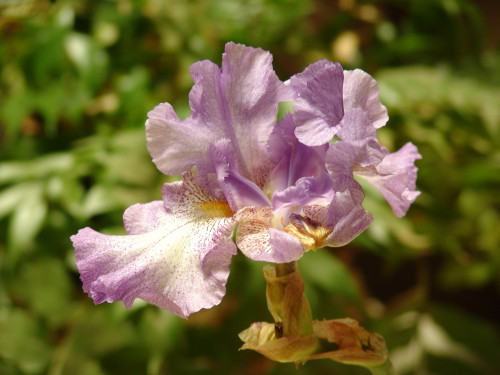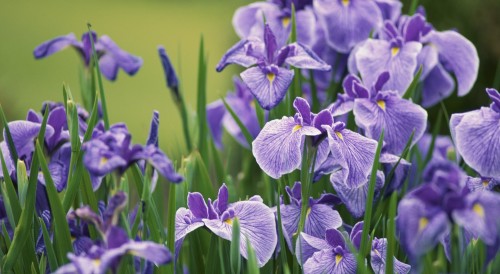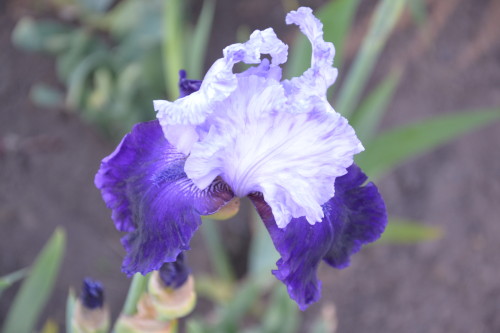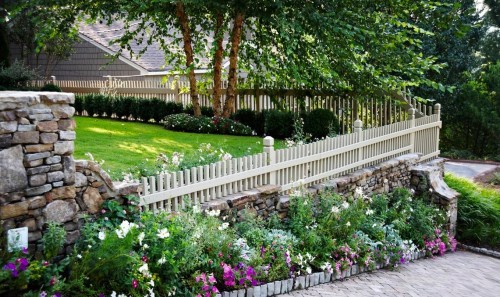Flowers of Iris since ancient times amazed the imagination of man. Their bizarre forms and colorful colors were delighted and inspired artists, thinkers and representatives of other creative professions.
Iris Japanese: Features
- On the island of Crete, Iris are depicted on ancient frescoes whose age is approximately 4,000 years. The plantings of these wondrous plants were surrounded by palaces and temples, the nodies of the famous nobility.
- The Iris flower got its name in ancient Greece in honor of the goddess Irida, who descended from heaven to Earth through the Heavenly Bridge in the form of a rainbow. The word "iris" from Greek is exactly what is translated - "Rainbow".
- Slavic peoples called this elegant plant more landingly - "kalescock" or "cock", due to the form of petals resembling a fish scallop. In the folk work of Slavs, the Irises were also multiple times known in different ways. These flowers decorated fabrics in the form of embroidery, dishes, buildings walls.
- In our time, Iris is getting acquainted most often with decorative goals, because this flower is a very colorful decoration of gardens and flower. However, there are other ways to use its inflorescences.
- In Azerbaijan, so far from his petals is boiled with a gentle jam. From iris, it is very expensive and elite essential oil, which is added only to expensive perfume. Sometimes this plant is used as an aroma and added to baking. Unfortunately, the high price of such a spice does not allow widespread its beautiful flavors.
Types of Irisov
There are many different types of irises that moved from wildlife to seedlings of breeders. Thanks to the scientists, many color varieties of plants were artificially derived and grafted by plants are more resistant for different weather phenomena characteristics.
In nature, irises grow on swamp areas and on the outskirts of forests of Japan, China, Myanmar. Iris Japanese a long time was not known in other states due to the closed worldview of the Japanese. But now everything has changed, and the varieties of Japanese iris, becoming more frost-resistant, are already very common everywhere.
Bearded irises
Bearded types of irises are very popular among flowers lovers. Their lower petals have grown in the form of bristles resembling a beard. Different varieties of bearded irises differ in height and size of the flower.
For example, high grades bloom their large inflorescences at an altitude above 70 cm. Burgundy grades of bearded irises have an increase of 40 to 70 cm, and miniature irises are the smallest among their bearded relatives, having a height of up to 70 cm and rather small flowers.
Characteristics of varieties
- The Iris flower has 6 parts of the perianth:
- fouls - lower level of petal;
- standards - upper levels of petals resembling dome;
- beard - thick porcelines of the lower petals.
- Inside the flower there are pestle and stamen, reliably protected by upper petals.
- Bearded varieties of irises can have very interesting combinations of colors, which are given specific names:
- AMAN - the upper petals of white and fouls of any other color, and maybe the opposite;
- Monochrome - all petals of the flower of Iris of one color;
- Two-color - various colors of the lower and upper petals;
- two-dimensional - petals are painted in different shades of the same color, while the upper level of petals is usually brighter;
- Neglet - light blue top and more darkened bottom flower;
- Plikat - the edge of the petals will emphasize the expressive edging of another color;
- lumage - lower petals have light lines and a light area near the bristles;
- Variagates - yellow top and brown or purple bottom;
- Blynd is a few coloring petals with a smooth transition from one to another.
- According to the timing of flowering, the bearded iris varieties are also different. They can be earliest, medium and late.
Beforeborive irises
The most famous representatives of the faboride irises are Siberian and Japanese varieties.
Siberian irises
The Siberian Iris is not only beautiful, he is also unpretentious to climatic conditions. They are not afraid of frost, winds, practically do not hurt. Have several flowers on one plant and a very expressive greens.
Not only are these plants themselves have high immunity, so they are also treated with the soil in which they grow, from pathogenic microbes. Approximately 4 years from malicious microorganisms in the ground there will be no trace.
Japanese irises
These representatives of the country of the rising sun are more demanding to the environment. Irises in their homeland symbolize samurai warriors. Flowers need weakness soil and in the moderate amount of moisture during flowering. During the rest of the time, they are sufficiently enduring in the arid conditions.
Outstanding Russian Botanist - Edward Regell, who was the director of the Botanical Garden in St. Petersburg, was very fascinated by the removal of frost-resistant varieties of Japanese iris. Initially, he suffered a few failures, but after the separation of Seeds of Japanese Iris from East China, a great progress was achieved by scientists. The years of the revolution were prevented by the work of Botany and his like-minded people, but in 20-30 years of 20 centuries, these works were resumed again.
Another follower - Vasily Alferov, adopted the desire to preserve and increase the variety of varieties of Japanese irises. He became a real guardian angel for a collection of Japanese irises in the difficult years of the Great Patriotic War.
Varieties of Japanese iris
Irises in Japan are very popular. In this country, landing gardens are planted, which are usually located in lowlands. For the time of flowering, the Japanese is poured with water planting irises, since at this time the flowers need extra moisture. Many people, admiring the beauty of these plants, believe that irises are aquatic plants. But this is not quite so, because after they blend, their plantations are dried.
Admire the beauty of iris buds is made on top to appreciate the grace of the flower.
The most famous varieties of Japanese Irisa:
- "Vasily Alferov" - a plant with a height of 110 cm, with a flower diameter of about 20 cm of violet color. Flowers from late June for 19 days.
- Altai - Plant flowers from July for a month for 14 days of purple flowers.
- A six-chapkit - differs from other varieties with flowers consisting of 6 petals.
- The ghost of happiness - the flower also consists of 6 white petals with lilac divorces, which are then inconspicuous. This low plant with a length of 90 cm blooms in July for 16 days.
Japanese iris has its advantages and disadvantages. The advantages include its large, expressive flowers that bloom up to 5 days, wind resistance, immunity to bacteriosis. His weaknesses are the lack of fragrance, low tolerability of wintering.
Selection of space for landing Japanese irises
Irises love lull and abundance of sunlight. Only Siberian Irises prefer more than half of them, since their gentle inflorescences do not like the scorching sun.
The soil can be of different composition: loam, sandy soils. Raw clay soil plots are better mixed with sandy or peat components. In lowlands, where much moisture, only marsh types of irises feel well.
Landing of irises rhizomes
- Place the irises well in the fall, when the summer heat ended and until the autumn October cold is still far away. Before boarding, it is necessary to move the soil and, if necessary, mix with sand.
- Make a deepening in the soil at a depth of 15 cm. In the center of the pits, we smell a small hollyk. Rhizome is placed so that the roots will lower in the deepening around the Holmik, and the root itself is placed on the elevation. After that, we sprinkle the roots of the roots and fix the back, but it should be visible on the surface. The roots need to generously pour water.
- Beautifully looks like the plantings of irises, landed in a circle. The plant does not need the mulching of the soil, more prefers feeding the Earth with mineral fertilizers at the beginning of spring.
Planting Lukovitz Irisov
The landing of the bulbs of Iris is better to produce in September. The soil is prepared in the same way as for the rhizomes of the irises, and lower the bulb into the deepening to the sharp end. The distances between the bulbs are better to withstand about 15 cm. Plant covers the mulch and leave it on the soil until the risk of frosts is preserved. With the onset of heat, insulation with the soil is cleaned and give plants the possibility of a proportion.
Transplanting Irisov
- The transplant of Iris is produced 2 weeks after the plants are swing. Flowers with land are transferred to another place at any warm time.
- The appearance of young green shoots is the right time to transplant. Prepare a bed for resetting is necessary since autumn: add humus and easily easily lime.
- They dig 40 cm wide and a depth of 15 cm. At its bottom there are 5 small elevations, for which the root leaves are placed up. Roots gently straighten and fall asleep soil. Then, watering plantations. Rhizomes of irises must be under a thin layer of land with a thickness of 1 cm.
Care for irises
- The Japanese Iris is a perennial plant, so the care of this plant needs to be organized. From weeds it is better to get rid of manually to avoid damage to the roots, which are located shallow from the surface of the soil. Soil looser should also be done very carefully. After the bearded irises grow, they no longer need a weeding, but bulbous varieties require more careful care.
- In the fall, you need to get rid of yellowed leaves, and even better cut about half of all the leaves.
- In winter, plants need to be sealed with oak leaves, and to cover with a cellophane film from above. After the winter departure, you should not slow with insulation cleaning, to give the opportunity to grow plants soon. At the same time, it is impossible to allow excessive soil dryness. To reduce all the difficulties of minimizing, it is better to plant irises in special containers that are better placed on the winter in a warm room.
- You can make fertilizers only in the raised soil in the spring. First, nitrogen and phosphorus are added to the soil, and after 2 weeks - a combination of nitrogen and potassium. 3 weeks after the end of flowering, nitrogen, phosphorus and potassium are added. The main thing is not to tighten with fertilizers at a later period, otherwise nitrogen will not bring benefits, but will prevent normal plants wintering.
- In order for the plant well to move the winter, since August is less water, but they do not allow to grow weeds.
- If the summer heat was installed, then watering the irises is better spent in the evening and at the same time try not to get into flowers. If the weather is windy, then the plants are linked, otherwise they can break.
Protection against pests
- Among the pests of the irises are called a wire, gladiolus TRIPS, winter and clock scoop, as well as naked slugs. If they are detected, then plants need to spray with special solutions - confident, mosilan or actar 1 time per week. For prevention, spraying is made 1.5 months before flowering.
- To get rid of the slugs, it is enough to sprinkle the earth as a ash, egg shell, powder mustard.
- Iris's flowers threaten bronze. These are pretty large beetles with a beautiful tint on the wings. They do not like cold, so they can be sprinkled with cold water, which leads insects into a stupor. After that, the beetles can simply shake into any water or kerosene container.
Protection against disease
- Iris may hurt rot feeding and bacteriosis.
- The rot is striking the iris in the case of too deeply landing, so it is recommended that the rhizer fall asleep the earth is not completely. When the root of the iris begins to rot, then the leaf drying is occurring. They change the color and are easily separated from the stem.
- The sick plant digs out of the soil and cut out the affected part of the root. The remaining part is treated with manganese, iodine or other special medicine. Then leave in the sun at least 8 hours, periodically turning the root.
- The soil in which the affected plant was dug and get rid of it. Old iris leaves are separated from the plant and burn. If you notice the wrinkling of the leaves of the Iris, then you do not need to take it for the disease, such a phenomenon will soon pass by itself.
Drops of flower
- Root system Japanese irises is located near the surface of the soil. When you think what to plant a Japanese iris, stop your choice on those perennial plants whose roots will be more deeply.
- If you want to decorate the path of the iris, then near the paths planted the lowest types of irises, and behind them - higher varieties. By the same principle you can organize a flowerbed, in the center of which will be the highest irises, and at the edges are lower.
- Beautifully look at the neighborhood of the planting of iris and spirea bushes. To make sure that, find a photo of Japanese Iris and Spirea on the Internet, which can inspire you to create such beauty on your site.
Japanese irises are a wonderful decoration of your garden or giving. Being very warm at first, now more unpretentious and frost-resistant varieties have been displayed, capable of delighting eyes in climate conditions far from Japanese.




















 Start a discussion ...
Start a discussion ...